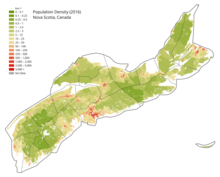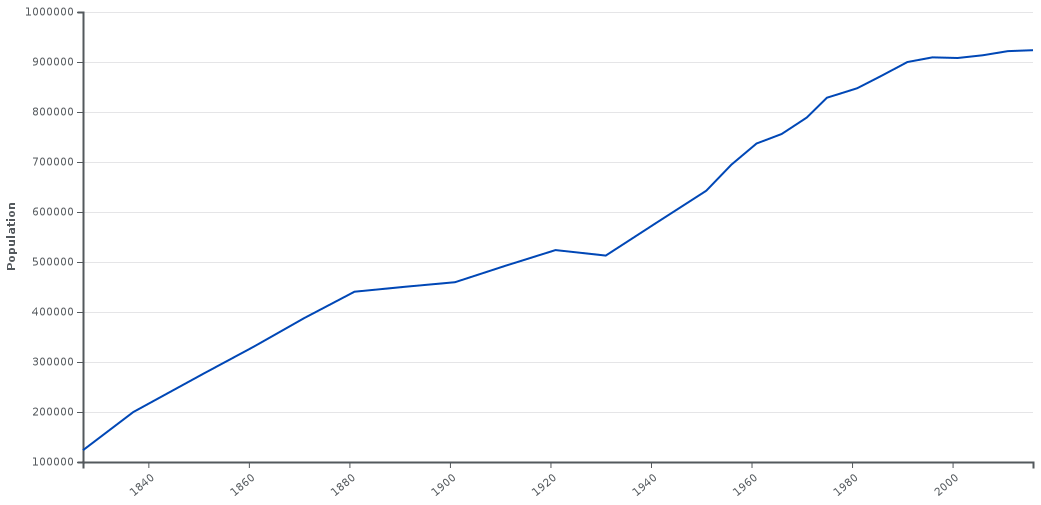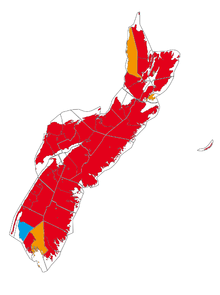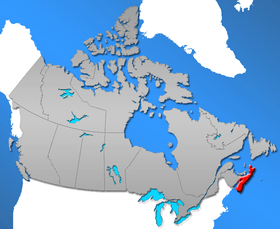Demographics of Nova Scotia
Nova Scotia (Latin for New Scotland; French: Nouvelle-Écosse; Scottish Gaelic: Alba Nuadh) is a Canadian province located on Canada's southeastern coast. It is the most populous province in the Atlantic Canada, and its capital, Halifax, is a major economic centre of the region. Nova Scotia is the second smallest province in Canada, with an area of 55,284 km². As of 2016, it has a population of 923,598 [1] making it the second most densely populated province of the country.[2]

Population
Nova Scotia is the seventh most populous province in Canada with an estimated 965,382 residents in 2019.[3] It accounts for less than 3 percent of the population of Canada while the population density is approximately 17.4 per square kilometer.[4] Furthermore, 60% of the population live in rural parts of the province.
Regional municipalities
Nova Scotia has three regional municipalities.
Towns
Nova Scotia has 26 towns, not including the former Town of Canso that dissolved to become part of Guysborough County on July 1, 2012 and the former Towns of Bridgetown and Springhill which dissolved on April 1, 2015.[6]
Population centres
The Halifax population centre is the largest urban area in Nova Scotia. Statistics Canada recognizes a total of 37 population centres in the province.[7]
| Population centres of Nova Scotia | |||||
|---|---|---|---|---|---|
| Rank | Population centre | Size group | Population in 2016 | Population in 2011 | % Change |
| 1 | Halifax | Large urban | 316,701 | 304,979 | +3.8% |
| 2 | Sydney | Small | 29,904 | 30,175 | -0.9% |
| 3 | Truro | Small | 22,954 | 22,470 | +2.2% |
| 4 | New Glasgow | Small | 18,665 | 19,623 | -4.9% |
| 5 | Glace Bay | Small | 17,556 | 18,475 | -5.0% |
| 6 | Sydney Mines | Small | 12,823 | 12,964 | -1.1% |
| 7 | Kentville | Small | 12,088 | 12,124 | -0.3% |
| 8 | Amherst | Small | 9,550 | 9,868 | -3.2% |
| 9 | Bridgewater | Small | 8,532 | 8,241 | +3.5% |
| 10 | New Waterford | Small | 7,344 | 7,322 | +0.3% |
| 11 | Yarmouth | Small | 7,217 | 7,367 | -2.0% |
| 12 | Kingston - Greenwood | Small | 6,879 | 6,840 | +0.6% |
| 13 | Enfield - Lantz | Small | 6,807 | 5,941 | +14.6% |
| 14 | Windsor | Small | 5,248 | 5,013 | +4.7% |
| 15 | Antigonish | Small | 5,002 | 5,049 | -0.9% |
| 16 | Wolfville | Small | 4,195 | 4,269 | -1.7% |
| 17 | Port Hawkesbury | Small | 3,004 | 3,167 | -5.1% |
| 18 | Springhill | Small | 2,743 | 2,978 | -7.9% |
| 19 | Pictou | Small | 2,711 | 2,909 | -6.8% |
| 20 | Liverpool | Small | 2,549 | 2,624 | -2.9% |
| 21 | Lake Echo | Small | 2,515 | 2,682 | -6.2% |
| 22 | Berwick | Small | 2,449 | 2,368 | +3.4% |
| 23 | Eskasoni 3 | Small | 2,120 | 1,940 | +9.3% |
| 24 | Lunenburg | Small | 2,085 | 2,126 | -1.9% |
| 25 | Digby | Small | 2,060 | 2,152 | -4.3% |
| 26 | Still Water Lake | Small | 1,586 | 1,682 | -5.7% |
| 27 | Hantsport | Small | 1,560 | 1,565 | -0.3% |
| 28 | Chester | Small | 1,529 | 1,484 | -1.8% |
| 29 | Brookside | Small | 1,441 | 1,531 | -5.9% |
| 30 | Middleton | Small | 1,391 | 1,390 | +0.1% |
| 31 | Shelburne | Small | 1,330 | 1,228 | +8.3% |
| 32 | Inverness | Small | 1,248 | 1,221 | +2.2% |
| 33 | English Corner | Small | 1,151 | 1,095 | 5.1% |
| 34 | Hayes Subdivision | Small | 1,121 | 1,090 | +2.8% |
Population of Nova Scotia since 1851

| |||||||||||||||||||||||||||||||||||||||||||||||||||||||||||||||||||||||||||||||||||||||||||||||||||||||||||||||||||
Source:[8] Statistics Canada [9][10]
* among provinces.
** Preliminary 2006 census estimate.
Ethnic origin
Note: the percentages do not necessarily add up to 100% as multiple responses are allowed. Ethnic origins with less than 2% of the responses are not listed.[11]
| Ethnic origin (Canada 2016 Census) | ||
|---|---|---|
| Population group | Population | % of total population |
| Canadian | 387,360 | 42.6% |
| Scottish | 272,880 | 30.0% |
| English | 262,375 | 28.9% |
| Irish | 195,865 | 21.6% |
| French | 149,625 | 16.5% |
| German | 97,555 | 10.7% |
| First Nations (North American Indian) | 48,640 | 5.4% |
| Dutch (Netherlands) | 32,045 | 3.5% |
| Métis | 26,025 | 2.9% |
| Acadian | 23,700 | 2.6% |
Visible minorities and Aboriginals
| Visible minority and Aboriginal population (Canada 2011 Census) | |||
|---|---|---|---|
| Population group | Population | % of total population | |
| White | 825,050 | 91% | |
| Visible minority group Source:[12] | South Asian | 4,965 | 0.5% |
| Chinese | 6,050 | 0.7% | |
| Black | 20,790 | 2.3% | |
| Latin American | 1,360 | 0.2% | |
| Filipino | 1,890 | 0.2% | |
| Arab | 6,290 | 0.7% | |
| Southeast Asian | 1,155 | 0.1% | |
| West Asian | 1,365 | 0.2% | |
| Korean | 960 | 0.1% | |
| Japanese | 445 | 0% | |
| Visible minority, n.i.e. | 720 | 0.1% | |
| Multiple visible minority | 1,290 | 0.1% | |
| Total visible minority population | 47,270 | 5.2% | |
| Aboriginal group Source:[13] | First Nations | 21,895 | 2.4% |
| Métis | 10,050 | 1.1% | |
| Inuit | 695 | 0.1% | |
| Multiple Aboriginal identity | 225 | 0% | |
| Aboriginal, n.i.e. | 980 | 0.1% | |
| Total Aboriginal population | 33,850 | 3.7% | |
| Total population | 906,175 | 100% | |
Languages
Knowledge of languages
The question on knowledge of languages allows for multiple responses. The following figures are from the 2016 Canadian Census, and lists languages that were selected by at least one per cent of respondents.
| Language | Responses | % |
|---|---|---|
| English | 905,020 | 99.63 |
| French | 95,740 | 10.54 |
| Arabic | 9,685 | 1.07 |
Mother tongue

The 2011 Canadian census showed a population of 921,727.
Of the 904,285 singular responses to the census question concerning mother tongue the most commonly reported languages were:
| Ranking | Language | Population | Percentage |
|---|---|---|---|
| 1. | English | 836,085 | 92.46% |
| 2. | French | 31,105 | 3.44% |
| 3. | Arabic | 5,965 | 0.66% |
| 4. | Algonquian languages | 4,685 | 0.52% |
| Mi'kmaq | 4,620 | 0.51% | |
| 5. | German | 3,275 | 0.36% |
| 6. | Chinese | 2,750 | 0.30% |
| Mandarin | 905 | 0.10% | |
| Cantonese | 590 | 0.06% | |
| 7. | Dutch | 1,725 | 0.19% |
| 8. | Spanish | 1,545 | 0.17% |
| 9. | Canadian Gaelic | 1275 | 0.14% |
| =10. | Tagalog Language | 1.185 | 0.13% |
| =10. | Persian | 1,185 | 0.13% |
| 11. | Polish | 825 | 0.09% |
| =12. | Korean | 815 | 0.09% |
| =12. | Russian | 815 | 0.09% |
| 14. | Italian | 790 | 0.09% |
| 15. | Greek | 775 | 0.08% |
| 16. | Scandinavian languages | 595 | 0.06% |
| Danish | 175 | 0.02% | |
| Norwegian | 125 | 0.02% | |
| Icelandic | 120 | 0.01% | |
| Swedish | 85 | 0.01% | |
| 17. | Urdu | 540 | 0.06% |
| 18. | Serbo-Croatian languages | 520 | 0.06% |
| Croatian | 210 | 0.02% | |
| Serbo-Croatian | 105 | 0.01% | |
| Bosnian | 90 | 0.01% | |
| Serbian | 115 | 0.01% | |
| 19. | Hindi | 515 | 0.06% |
| 20. | Vietnamese | 450 | 0.05% |
| 21. | Portuguese | 380 | 0.04% |
| 22. | Bengali | 375 | 0.04% |
| 23. | Panjabi | 370 | 0.04% |
| 24. | Celtic languages | 330 | 0.04% |
| 25. | Japanese | 305 | 0.03% |
| 26. | Ukrainian | 300 | 0.03% |
| 27. | Hungarian | 280 | 0.03% |
| 28. | Czech | 180 | 0.02% |
| 29. | Romanian | 170 | 0.02% |
| 30. | Gujarati | 105 | 0.01% |
There were also 275 single-language responses for Turkish; 195 for Non-verbal languages (Sign languages); 30 for Malay; 100 for Bantu languages; 70 for Kurdish; 120 for Slovak; and 5 for Estonian. Figures shown are for the number of single language responses and the percentage of total single-language responses.[14]
Migration
Immigration
The 2016 Canadian census counted a total of 55,675 immigrants living in Nova Scotia.
The most commonly reported origins for these immigrants were:
[15]
| Country | Immigrants | |
|---|---|---|
| 1. | United Kingdom | 11,275 |
| 2. | United States | 7,375 |
| 3. | China | 2,850 |
| 4. | Germany | 2,600 |
| 5. | Philippines | 2,570 |
| 6. | India | 2,225 |
| 7. | Netherlands | 1,645 |
| 8. | Lebanon | 1,370 |
| 9. | Syria | 1,150 |
| 10. | Iran | 970 |
| 11. | South Korea | 870 |
| 12. | Egypt | 770 |
| 13. | Poland | 630 |
| 14. | Pakistan | 615 |
| 15. | France | 610 |
| 16. | Russian Federation | 585 |
| 17. | Italy | 525 |
| 18. | Iraq | 525 |
| 19. | Greece | 505 |
| 20. | Jamaica | 480 |
There were also 475 immigrants from the Republic of Ireland; 460 from South Africa; 450 from Vietnam; 350 from Nigeria; 335 from Ukraine; 325 from Mexico; 315 from Bangladesh; 310 from Sri Lanka; 280 from Hong Kong; 225 from Japan; 225 from Taiwan; 220 from Trinidad and Tobago; 220 from Portugal; and 210 from Bosnia and Herzegovina.
Recent immigration
The 2016 Canadian census counted a total of 11,785 recent immigrants living in Nova Scotia, defined as "an immigrant who first obtained his or her landed immigrant or permanent resident status between January 1, 2011 and May 10, 2016."[16]
The most commonly reported origins for these recent immigrants were:
| Country | Immigrants | |
|---|---|---|
| 1. | Philippines | 1,500 |
| 2. | United Kingdom | 1,080 |
| 3. | China | 985 |
| 4. | India | 900 |
| 5. | Syria | 890 |
| 6. | United States | 615 |
| 7. | Israel | 290 |
| 8. | Iran | 260 |
| 9. | Iraq | 245 |
| 10. | South Korea | 225 |
| 11. | Germany | 215 |
| 12. | Egypt | 205 |
| 13. | Nigeria | 200 |
| 14. | Jamaica | 195 |
| 15. | Nepal | 185 |
| 16. | Russian Federation | 180 |
| 17. | Pakistan | 145 |
| 18. | Ukraine | 140 |
| 19. | Saudi Arabia | 125 |
| 20. | France | 110 |
There were also 105 recent immigrants from Mexico; 100 from Sri Lanka; 100 from Turkey; 95 from Brazil; 80 from South Africa; 80 from Bangladesh; 75 from the Republic of Ireland; 75 from Lebanon; 70 from Cuba; 70 from Eritrea; 70 from Japan; 70 from the United Arab Emirates; 65 from Vietnam; and 55 from the Democratic Republic of the Congo.
Internal migration

From 1971 to 2012, Nova Scotia had a persistent negative trend in net interprovincial migration. Combined with a declining birth rate, this poses a significant demographic challenge for the province, as its population is projected to decline from 948,000 people in 2011 to 926,000 people in 2038. The destination for Nova Scotia migrants was most often Ontario, until the turn of the 21st century when Alberta became a more popular destination; New Brunswick ranks as a distant third.[17]
| In-migrants | Out-migrants | Net migration | |
|---|---|---|---|
| 2008–09 | 15,467 | 16,218 | −751 |
| 2009–10 | 15,172 | 14,560 | 612 |
| 2010–11 | 14,553 | 14,594 | −41 |
| 2011–12 | 14,410 | 17,276 | −2,866 |
| 2012–13 | 12,630 | 16,147 | −3,517 |
| 2013–14 | 13,402 | 15,973 | −2,571 |
| 2014–15 | 13,854 | 16,165 | −2,311 |
| 2015–16 | 15,107 | 14,353 | 754 |
| 2016–17 | 15,339 | 12,500 | 2,839 |
| 2017–18 | 15,509 | 12,461 | 3,048 |
| 2018–19 | 17,324 | 14,018 | 3,306 |
Source: Statistics Canada
Religion

| Religion | Population | Pct (%) |
|---|---|---|
| Catholic | 298,270 | 32.92% |
| No religious affiliation | 197,665 | 21.81% |
| United Church | 109,700 | 12.10% |
| Anglican | 100,120 | 11.05% |
| Baptist | 80,815 | 8.92% |
| Other Christian | 55,555 | 6.13% |
| Presbyterian | 23,555 | 2.60% |
| Pentecostal | 9,595 | 1.06% |
| Lutheran | 9,485 | 1.05% |
| Muslim | 8,505 | 0.94% |
| Christian Orthodox | 3,370 | 0.37% |
| Other religions | 2,720 | 0.30% |
| Buddhist | 2,205 | 0.24% |
| Hindu | 1,850 | 0.20% |
| Jewish | 1,805 | 0.20% |
| Traditional (Aboriginal) Spirituality | 570 | 0.06% |
| Sikh | 390 | 0.04% |
Employment
As of February 2019, the unemployment rate for the province is 6.4 percent. Halifax Regional Municipality 4.9 percent [19]
Income
| By County | By Community | |||||||||||||||||||||||||||||||||||||||||||||||||||||||||||||||||||||||||||||||||||||||||||||||||||||||||||||||||||||||||||||||||||||||||||||||||||||||||||||||||||||
|---|---|---|---|---|---|---|---|---|---|---|---|---|---|---|---|---|---|---|---|---|---|---|---|---|---|---|---|---|---|---|---|---|---|---|---|---|---|---|---|---|---|---|---|---|---|---|---|---|---|---|---|---|---|---|---|---|---|---|---|---|---|---|---|---|---|---|---|---|---|---|---|---|---|---|---|---|---|---|---|---|---|---|---|---|---|---|---|---|---|---|---|---|---|---|---|---|---|---|---|---|---|---|---|---|---|---|---|---|---|---|---|---|---|---|---|---|---|---|---|---|---|---|---|---|---|---|---|---|---|---|---|---|---|---|---|---|---|---|---|---|---|---|---|---|---|---|---|---|---|---|---|---|---|---|---|---|---|---|---|---|---|---|---|---|---|---|
|
|
Notes
|
Gross domestic product
Nova Scotia GDP is presently approximately $33 billion (Can) annually.
See also
References
- Government of Canada, Statistics Canada (2017-02-08). "Census Profile, 2016 Census - Nova Scotia [Province] and Canada [Country]". www12.statcan.gc.ca. Retrieved 2019-09-26.
- "Nova Scotia Population 2019". World Population Review.
- Government of Canada, Statistics Canada (2017-02-08). "Census Profile, 2016 Census - Nova Scotia [Province] and Canada [Country]". www12.statcan.gc.ca. Retrieved 2019-09-26.
- Government of Canada, Statistics Canada (2017-02-08). "Census Profile, 2016 Census - Nova Scotia [Province] and Canada [Country]". www12.statcan.gc.ca. Retrieved 2019-09-26.
- "Population and dwelling counts, for Canada, provinces and territories, and census subdivisions (municipalities), 2011 and 2006 censuses (Nova Scotia)". Statistics Canada. December 18, 2012. Archived from the original on April 13, 2014. Retrieved January 29, 2013.
- "Decision NSUARB-MB-10-2" (PDF). Nova Scotia Utility and Review Board. January 19, 2012. Retrieved January 29, 2013.
- Population and dwelling counts, for Canada, provinces and territories, and population centres, 2011 and 2006 censuses: Nova Scotia Archived 2016-03-04 at the Wayback Machine. Statistics Canada.
- Belshaw, John Douglas (2015). "10.2 Demographics". Canadian History: Pre-Confederation. BCCampus.
- Canada's population Archived November 4, 2008, at the Wayback Machine. Statistics Canada. Last accessed September 28, 2006.
- Population urban and rural, by province and territory (Nova Scotia) Archived 2006-11-21 at the Wayback Machine. Statistics Canada, 2005.
- Canada, Government of Canada, Statistics. "Census Profile, 2016 Census, Nova Scotiat". 12.statcan.gc.ca. Retrieved 30 December 2019.
- "Archived copy". Archived from the original on 2017-03-04. Retrieved 2017-03-03.CS1 maint: archived copy as title (link), Community Profiles from the 2011 Census, Statistics Canada - Province/Territory
- "Archived copy". Archived from the original on 2017-03-04. Retrieved 2017-03-03.CS1 maint: archived copy as title (link), Aboriginal Population Profile from the 20062011Census, Statistics Canada - Province/Territory
- Canada, Government of Canada, Statistics. "Statistics Canada: 2011 Census Profile". www12.statcan.gc.ca. Archived from the original on 2018-05-27.
- Canada, Government of Canada, Statistics. "Census Profile, 2016 Census, Nova Scotiat". 12.statcan.gc.ca. Retrieved 8 February 2020.
- Canada, Government of Canada, Statistics. "Census Profile, 2016 Census, Nova Scotiat". 12.statcan.gc.ca. Retrieved 8 February 2020.
- Rashti, Amir Ahmadi; Koops, Adrian; Covey, Spencer (Spring 2015). "The Effects of Capital on Interprovincial Migration: A Nova Scotia Focused Assessment". Dalhousie Journal of Interdisciplinary Management. 11: 28.
- Statistics Canada Archived 2014-10-26 at the Wayback Machine National Household Survey, for Province of Nova Scotia, 2011 census - 100% data
- https://www150.statcan.gc.ca/t1/tbl1/en/tv.action?pid=1410028703. Missing or empty
|title=(help) Unemployment rate - National Household Survey (NHS) Profile - Select from a List Archived 2014-05-12 at the Wayback Machine Statistics Canada
